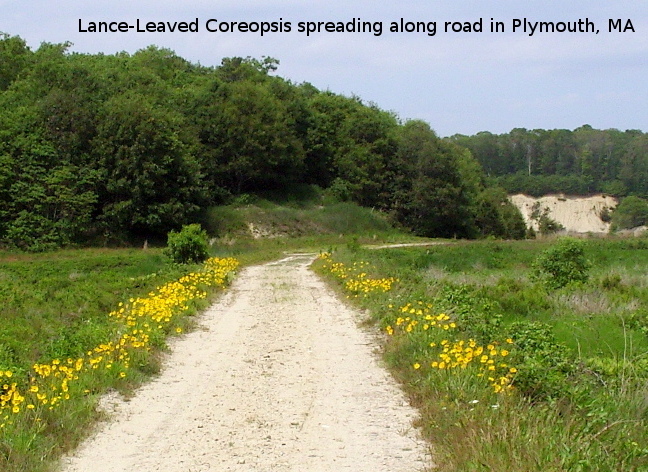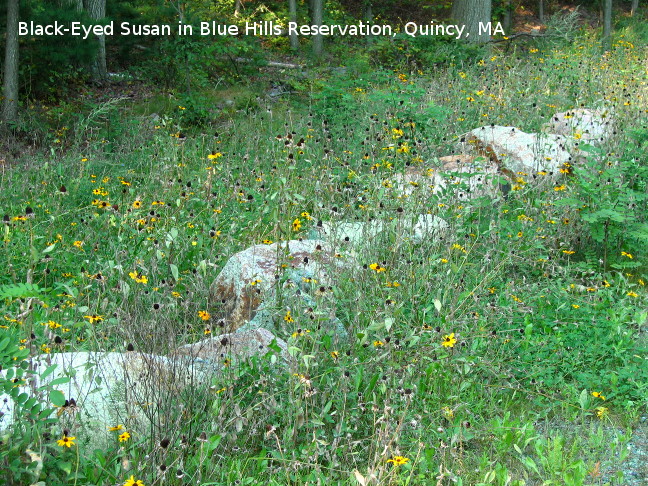Northeast Pollinator Wildflower Seed Mix Analysis
The wildflower mix advertized by the
American Meadows
as "new" (10 June 2017) is described as follows.
The Northeast Pollinator Mix is carefully formulated with annual and perennial varieties to help
a wide variety of pollinators in the Northeast region, including
Connecticut, Delaware, Maine, Maryland, Massachusetts, New Hampshire, New Jersey, New York, Pennsylvania, Rhode Island, Vermont and West Virginia.
This mixture is also great for the Province of Quebec, Newfoundland, Labrador, PEI, New Brunswick and Nova Scotia.
The colorful, easy-to-grow wildflowers bloom from spring until frost, when many pollinators are on their migration journey and need nectar most.
Here are all the 18 species included in the described mix with comments on their origin taken from the Flora of North America and Massachusetts County Checklist [1] (obviously, the percentage of native plants would somewhat vary for different areas within the "Northeast" as it is specified at the web site).
- Siberian Wallflower (Cheiranthus allionii) — native in Eurasia and North Africa
- Four O’Clocks (Mirabilis jalapa) — native in Mexico
- Blue Flax (Linum perenne) — native in Eurasia
- Lance-Leaved Coreopsis (Coreopsis lanceolata) — within New England native only in New Hampshire
- Sulphur Cosmos (Cosmos sulphureus) — native in Mexico
- Sweet William Pinks (Dianthus barbatus) — native in Eurasia
- Indian Blanket (Gaillardia pulchella) — native in New England outside Massachusetts
- Cornflower (Centaurea cyanus) — native in Europe
- Perennial Lupine (Lupinus perennis) — native in Massachusetts
- Cosmos (Cosmos bipinnatus) — native in eastern North America yet alien in Massachusetts, reported only as waifs in central MA counties
- California Poppy (Eschscholzia californica) — native on the West Coast
- Red Poppy (Papaver rhoeas) — native in Europe, Southwest Asia, North Africa
- Catchfly (Silene armeria) — native in Europe
- Butterfly Weed (Asclepias tuberosa) — native in Massachusetts
- Black-Eyed Susan (Rudbeckia hirta) — native in eastern North America yet alien in Massachusetts; var. pulcherrima naturalized in every Massachusetts county
- New England Aster (Aster/Symphyotrichum novae-angliae) — native in Massachusetts
- Plains Coreopsis (Coreopsis tinctoria — native in eastern North America yet alien in Massachusetts, not even introduced to eastern MA, except for the islands
- Evening Primrose (Oenothera biennis) — native in Massachusetts

- Here are some references regarding each of these potentially invasive plants.
- Lance-Leaved Coreopsis (Coreopsis lanceolata) — Naturalized in MA. Considered invasive in Japan. According to our own observations (2015-2016), this aggressive plant has been spreading into fragments of the native sandplain grassland at Tidmarsh Farms in Plymouth.
- Sulphur Cosmos (Cosmos sulphureus) — Has not been naturalized in MA. Reference: [3]
- Cornflower (Centaurea cyanus) — Naturalized in MA. References: [3] [4] [5]
- Cosmos (Cosmos bipinnatus) — Naturalized in MA. Reference: [3]
- California Poppy (Eschscholzia californica) — Naturalized in MA. Reference: [3]
- Black-Eyed Susan (Rudbeckia hirta) — Naturalized in MA. Reference: [4]
- Plains Coreopsis (Coreopsis tinctoria) — Naturalized in MA. Potentially Invasive. References: [4] [6]

- Sorrie, B.A. and P. Somers. 1999. The Vascular Flora of Massachusetts: A County Checklist. Massachusetts Natural Heritage & Endangered Species Program, Massachusetts Division of Fisheries and Wildlife. Westborough, MA.
- Cullina, M. D., B. Connolly, B. Sorrie, and P. Somers. 2011. The Vascular Flora of Massachusetts: A County Checklist. First Revision Massachusetts Natural Heritage & Endangered Species Program, Massachusetts Division of Fisheries and Wildlife. Westborough, MA.
- Southeast Exotic Pest Plant Council. 1996. Invasive exotic pest plants in Tennessee (19 October 1999). Research Committee of the Tennessee Exotic Pest Plant Council. Tennessee.
- Southern Weed Science Society. 1998. Weeds of the United States and Canada. CD-ROM. Southern Weed Science Society. Champaign, Illinois.
- Whitson, T.D. (ed.) et al.. 1996. Weeds of the West. Western Society of Weed Science in cooperation with Cooperative Extension Services, University of Wyoming. Laramie, Wyoming.
- Stubbendieck, J., G.Y. Friisoe, and M.R. Bolick. 1994. Weeds of Nebraska and the Great Plains. Nebraska Department of Agriculture, Bureau of Plant Industry. Lincoln, Nebraska
Salicicola.com admins (AZ & IK) 11 June 2017
Salicicola Home